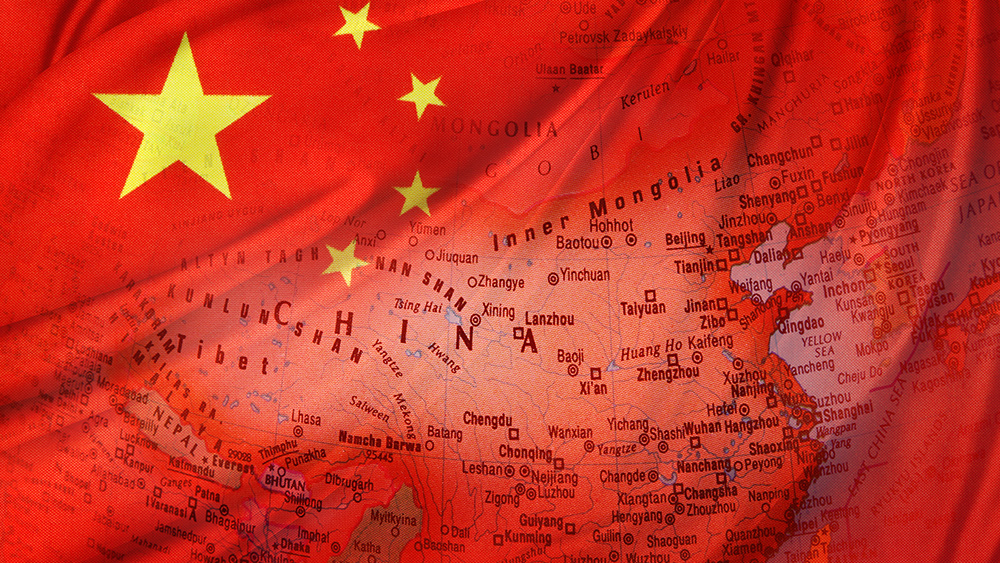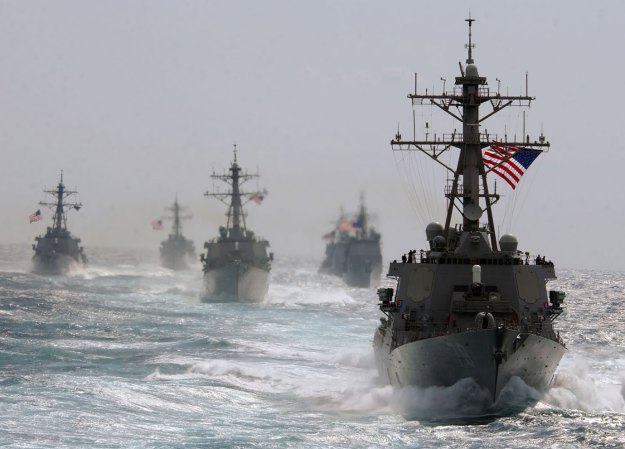China now building an airstrip on disputed island in South China Sea
08/28/2023 / By Zoey Sky

Alarming satellite images taken this August show that China has started construction of an airstrip on a disputed island in the South China Sea (SCS).
Analysis of a satellite image from Planet Labs PBC suggests that there is new construction on Triton Island, the westernmost island of the Paracel Islands near Vietnam.
China has occupied the Paracel Islands since the 1970s, but Taiwan and Vietnam also lay claim to the archipelago.
Compared with a Planet Labs PBC satellite image of the same island early in March, the latest image shows Beijing has been busy building up the island, which is about one mile by several thousand feet across.
Chinese airstrip could house aircraft and drones
Reports suggest that construction of the airstrip on Triton Island started within the last several weeks. According to the Associated Press, the airstrip could be more than 600 meters (2,000 feet) long, big enough for turboprop aircraft and drones.
The Triton Island airstrip is the latest indication that Beijing is staying on task to militarize islands as part of a broader strategy to expand China’s presence in the South China Sea.
In 2022, China fully militarized three islands in the South China Sea. According to the Pentagon, the move could be part of the country’s goal to destabilize the area. It could also allow China to extend its offensive capabilities beyond its own shores using flying fighters, bombers and other methods.
When pressed for answers, China has little to say about its construction work on islands in the South China Sea. The country only said that the project would help ships safely navigate the South China Sea. China also claimed that the construction is “defensive in nature.”
China has at times denied that it is building man-made islands in the South China Sea. The country also refuses to admit it is militarizing the region, which sees $5 trillion worth of trade pass through each year. (Related: Chinese fighter jet flies too close to US recon plane flying over South China Sea.)
Beijing’s recent behavior has become more aggressive
Despite claims to the contrary, there is proof that Beijing has been slowly building up reefs into islands in the South China Sea for years. Beijing has gradually been adding more military outposts and assets such as missiles, radar systems and airstrips.
In several cases where islands didn’t exist, China has strong-armed the creation of new islands in the sea. The aggressive move has earned criticism from the U.S., which sanctioned Chinese entities that help Beijing build artificial islands and militarize them.
Kitsch Liao, assistant director of the Atlantic Council’s Global China Hub, warned that these ambitious projects could help China with key logistics and enable it to “project force.” This is worrying because of Beijing’s increasingly aggressive and coercive behavior in the area in recent months.
Liao thinks the goal of the airstrip construction is recon, targeting and surveillance. Knowing what you can see and track is “the most important thing in the first opening shot of any potential war,” even in the runup to that, he added.
Within the last few years, China has equipped some Spratly Islands with anti-ship and anti-aircraft missile systems, as well as laser and jamming equipment and fighter jets. China steadily growing its territorial claims could be what it needs to successfully shape potential conflict in the region.
It remains to be seen if the islands would survive in a war. Si-fu Ou, from the Institute for National Defense and Security Research in Taiwan, warned that China could be aiming for “preparatory steps for conflict.”
The Great Walls of SCS have been built on sand, which leaves the area vulnerable during war because they are not defensible. But during peacetime, the man-made islands are ideal for different missions, such as “presence, ISR (intelligence, surveillance, and reconnaissance), situation awareness and gray zone-tactics,” said Ou.
Ou added that the airstrip under construction on Triton Island could help China threaten Vietnam, which he believes is China’s grand strategy in the SCS.
According to preliminary assessment, the buildup on Triton Island may be a secondary base in the Paracel Islands which could be used as an auxiliary base for the main base on Woody Island.
Woody Island is China’s major military base in the Paracel Islands. It has an estimated population of 1,000 and houses an airstrip, hangars for combat aircraft and HQ-9 surface-to-air missile batteries.
Triton Island airstrip could help China seize Taiwan
Brad Martin, a retired U.S. Navy officer and a senior policy researcher at RAND Corporation, said the Triton Island buildup could also be China’s attempt at making a potential move to seize Taiwan harder for its enemies to successfully counteract.
Despite claiming that its island buildup is defensive, there have been growing concerns that Beijing’s expanding influence and military outposts in the region could make it easy for China to send military assets to the islands when things go south.
China’s aggression has also raised questions about whether the country is now powerful enough to intervene with vital trade routes or try to hinder the transit of foreign nations’ aircraft or vessels while also claiming islands and nearby waters.
China’s buildup on islands overlaps with the territorial interests of several countries, including Brunei, the Philippines, Malaysia, Taiwan and Vietnam. Aside from China’s increasing threats to Taiwan, the former’s aggressive behavior toward Vietnam has been growing in the last few months.
Back in May, a Chinese research ship and five escort vehicles declined orders to leave Vietnam’s Exclusive Economic Zone (EEZ), the area of ocean that extends 200 nautical miles beyond a nation’s territorial sea.
When confronted about the entry into Vietnam’s EEZ, China’s foreign ministry was nonchalant about the issue, saying that the country is free to traverse the islands China lays claim to and their adjacent waters.
In 2023, China’s Coast Guard also had several encounters with the Philippines in the Spratly Islands.
China laying claim to islands by starting facilities and outposts
The construction on Triton Island as well as other islands in the SCS is part of Beijing’s strategy to prove the islands are China’s property.
Establishing facilities and outposts and moving people to these islands means Beijing wants to establish a “pattern of life” that emphasizes it is simply claiming Chinese territory.
Martin said that this move is sending a clear message: China has a right to be there and the country is bravely challenging others to dispute its claims.
The move has been ongoing yet gradual to perhaps ensure that the U.S. will not feel threatened enough to act, but it is enough to stake a claim in what China believes is its rightful territory.
The U.S. is currently trying to send a different message: The waters around these islands are not waters China can lawfully claim by conducting “freedom of navigation operations” (FONOPs) near the disputed islands.
Additionally, the U.S. has sent a U.S. guided-missile destroyer to conduct FONOPs near the Paracel and Spratly Islands on at least two occasions this year, just like it did in previous years, to prove the point. Ironically, the operations earned protests from Beijing, which claims the FONOPs violate China’s sovereignty.
Throughout the years, Triton Island seemed to have a crucial part in Beijing’s claim over the Paracel Islands, where large regions of territory are displaying China’s flag.
The satellite photos from Planet Labs reveal two large fields with what seem to be objects meant to represent China’s flag and the Chinese Communist Party (CCP). It’s still unclear if the construction on Triton Island will stop once the airstrip is finished.
However, China is maintaining its narrative. Recently, a foreign ministry spokesperson claimed in a press conference that Triton Island is “part of China’s inherent territory.”
Visit CommunistChina.news for the latest news about China.
Watch the video below to learn more about how China’s economy is moving into dangerous territory.
This video is from the NewsClips channel on Brighteon.com.
More related stories:
Russia and China pledge friendship, denounce the West.
China launches massive air, sea military exercise in practice run to invade Taiwan.
U.S. warns China about plans to increase military drills in South China Sea region.
Sources include:
Submit a correction >>
Tagged Under:
big government, chaos, China, Chinese military, communism, conflict, conspiracy, crybullies, dangerous, deception, insanity, military tech, national security, South China Sea, surveillance, Taiwan, Triton island, U.S. military, Vietnam, weapons technology, World War III
This article may contain statements that reflect the opinion of the author
RECENT NEWS & ARTICLES
COPYRIGHT © 2018 MILITARYTECHNOLOGY.NEWS
All content posted on this site is protected under Free Speech. MilitaryTechnology.news is not responsible for content written by contributing authors. The information on this site is provided for educational and entertainment purposes only. It is not intended as a substitute for professional advice of any kind. MilitaryTechnology.news assumes no responsibility for the use or misuse of this material. All trademarks, registered trademarks and service marks mentioned on this site are the property of their respective owners.



















